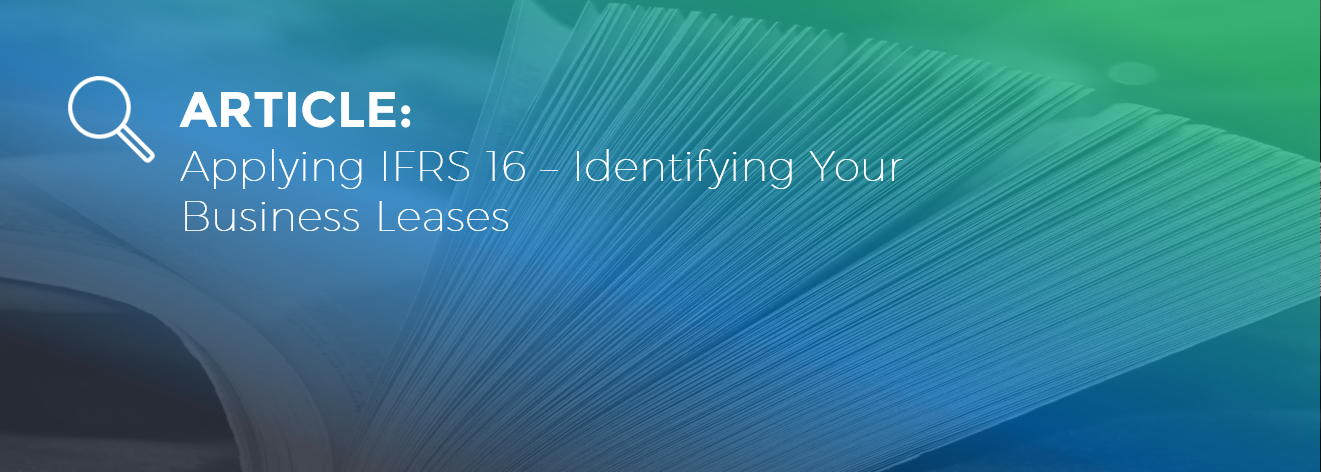Applying IFRS 16 – Identifying Your Business Leases
Updated 12th May 2021 | 6 min read Published 12th July 2018

Transition and Compliance:
Back in the day the International Accounting Standards Board (IASB) together with the Financial Accounting Standards Board (FASB) resolved to redefine the treatment of leases, their assets and their associated liabilities with regard to financial accounting and reporting.
The result was the creation of a new standard for those reporting under IASB (IFRS 16) and a similar standard under FASB rules (update ASC 842). IAS 17 and FAS 13 (ASC 840) will now disappear and from 2019 going forward lessees together with their auditors will be expected to be cognisant of the new standards and be prepared to apply them. Transition and compliance are the watchwords.
Previously it could be argued that FAS 13 and particularly IAS 17 were not definitive enough in particular areas and open to interpretation - thus serving more as guidelines than outright standards. Additionally, it was considered by the accounting bodies and other interested parties that the ability to classify certain leases as operating leases and report them as expenses on the P&L rather than as business assets and committed liabilities on the balance sheet could make the comparison of performance by a company difficult to interpret by potential investors, lenders and stakeholders.
Literally throwing everything out and starting again the IASB and FASB made sweeping changes –
- Redefining the definition of a lease
- Defining the “right of use asset” as the hallmark of an asset
- Exempting only low value rented assets (<$5,000) and short-term rental commitments (12 months)
- Determining that all leases will appear on the balance sheet as asset and liability
- Proscribing the interest rate options to be applied
- Requiring that all extant leases entered into prior to the adoption of the standard would need to be reviewed and if necessary be reclassified to meet compliance
- Ensuring that any assets existing as a right of use asset in any agreement previously treated as a service contract are together with their associated liabilities recognised as a lease under IAS 16 /ASC 842.
How will applying IFRS 16 affect your business:
Not at all if your business can identify and verify that it has not entered into and is not the lessee with regard to any lease agreements. For lessees, however, there is likely to be an increase in reported assets (right of use assets) and associated committed liabilities.
All leases will essentially be treated as finance leases and will be treated similarly to the IAS 16 accounting model. However, instead of a straight-line expense approach taken to the P&L for any operating leases, there will now be a front-loaded finance charge reflecting the lease liability after the classification or reclassification of the operating leases under IFRS 16/ASC 842.
It follows that, generally, financing costs and amortisation recognising the full committed liability of the lessee to a committed extant operating lease agreement will replace the expensing of rentals. Earlier in this blog exemptions were identified and these together with any variable lease payments not recognised in the initial liability can be expensed.
Cashflows associated with leases will change as repayments will need to be split and reported as interest and principal.
The financial ratios and metrics that your company use or those that lenders, lessors, investors or stakeholders analyse will change. Are these parties aware of how the changes will affect these ratios – are you yet in a situation where your company knows the impact?
Remember that debt covenants, key performance indicators, bonus targets, remuneration schemes, regulatory capital requirements and even tax liabilities may be affected.
How do you identify your business leases?
What a challenge if you do not have a database in place!
- Do you know which companies, subsidiaries, divisions and departments within your business do have or might have lease agreements in place? Even if you do, then it is likely some will be missed.
- Are you sure that all service agreements are exactly that and do not include any lease element?
- To be classified as a lease under the new standard the agreement will need to have an identifiable asset and allow the lessee the right of use of the asset.
- Who can direct the right of use? – if it’s not the lessee then it’s not a lease.
- Is substitution by the lessor of the assets allowed in the agreement? – if so then there may be no “lease” in place. If you can be moved to new premises, then you have a case of the property agreement being wrongly classified as a lease.
- If the lessor can use an asset to fulfil the agreement then again this “substitution” may define the contract as a service agreement.
- In asking for lease agreement details ensure that all property, plant and equipment commitments are requested and included.
- Are you confident that your existing systems and processes capture all leases? Are lease databases kept centrally or at unit level?
- Engage a consultancy specialising in transitioning companies to IFRS 16 and ASC 842 compliance – they will have already discovered the wheel and therefore the way to identify, classify and recognise leases.
- Ensure that you and all parties and personnel involved understand just what constitutes a lease under the new standards.
- There are still a few months until 2019 – will new agreements be signed between now and the date of final transition. Will any expiring leases be renewed?
- A project team now needs to be formed and involved. Do you have the resource? Are they skilled in the area of leases and lease accounting? Do they have the resource to call on? Has their existence and mission been communicated throughout the business? Do they have authority as well as responsibility?
- Gather all leases and service agreements. Collate and compile a database portfolio of each and every right of use asset and associated liabilities. Review and classify as required. Put in place processes and procedures to ensure this portfolio is managed in the future, kept current and up to date.
- If you have a lease agreement, then it is likely that the rentals whether finance lease or operating lease will be paid regularly and periodically – maybe even by direct debit. Check all bank statements that might have such payments and look to discover “unknown” or unreported leases.
Centralisation of all lease data
The transition to new accounting standards can be smooth and easy. The innovative and robust software solution from Innervision (LOIS Lease Accounting) centralises and stores all of your lease data and documentation, allowing for easy management, searching and reporting. Once key leasing information is available on LOIS then transitioning to compliance can be confidently embarked on and completed.
These are just a few of the ways Innervision’s lease management software can help your business. To find out more about the benefits our tools offer our clients, contact us today. If you’d also like to know more about the upcoming IFRS 16 regulations, take a look at how IFRS 16 will impact your accounting business and Innervision’s eBook detailing how to “Navigate the new definition of a lease under the IFRS 16”.


.png)